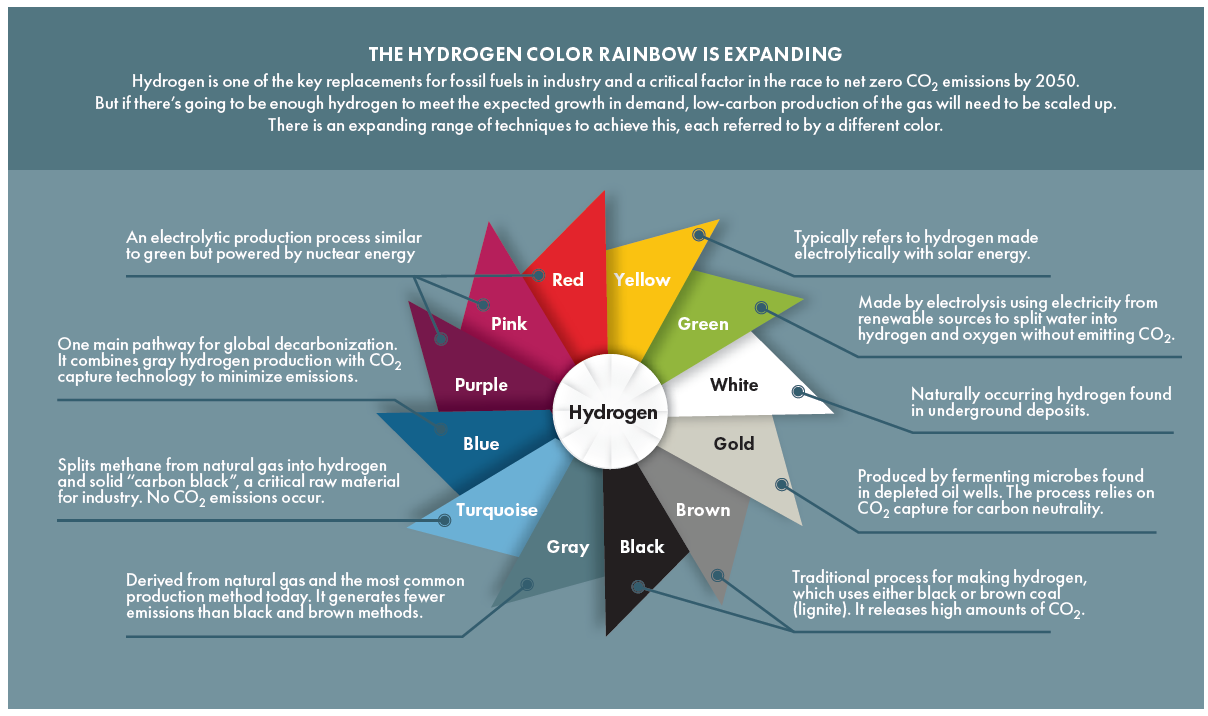Hydrogen Turbines in Power Generation
Hydrogen plays a significant role in decarbonizing power generation.
Hydrogen is the most abundant element in the universe. As a carbon-free energy source, it represents one of the paths to a decarbonized energy supply. Flipping the switch to a decarbonized, green tomorrow would be wonderful. The reality is that a number of considerations, technical advancements, socio-economic hurdles, and resource limitations need to be navigated first. This article explores the current state of hydrogen as a fuel supply; what can be accomplished within today’s installed base of power generation; identifies intermediate hydrogen-based carbon reduction solutions; and outlines the advancements necessary to realize the vision of an entirely hydrogen-fueled gas turbine power generation fleet.
When looking for carbon-free energy sources, the most apparent options are solar, wind, hydro, and nuclear. Yet each of these present unique constraints when asked to satisfy the world’s growing demand for electricity. With their fuel flexibility and high efficiencies, gas turbines have increasingly been relied upon to meet the growing global demand for power. Hydrogen represents a means to leverage this installed base to supply car-bon-free electricity in a less disruptive manner than a complete transformation to new power generating technologies. Fueling gas turbines with pure hydrogen produces only water vapor with zero CO2 emissions:
H2 + ½O2 -> H2O + 266 BTU/ft³
(lower heating value – LHV basis)
Hydrogen has been successfully blended with the fuel supply in gas turbines for decades. Recent field demonstration tests have shown successful operation at up to a 44% blend of H2 by volume for aeroderivative gas turbines, and up to 20% for large heavy-frame gas turbines. One concern with combusting hydrogen is increased NOx emissions due to increased flame temperature. Studies have demonstrated negligible change to NOx emissions.
Table 1: Hydrogen vs. natural gas properties

Gas turbine OEMs are projecting the capability to operate on 100% hydrogen without impacting NOx formation, primarily through advancements in combustor design and minor if any changes to existing SCR reliance.
The key to unlocking the full potential of hydrogen as a carbon-free energy source is to convert unused solar, wind, hydro, and nuclear energy available during low-demand periods to hydrogen via water electrolysis. The stored hydrogen produced can then be utilized as an alternate fuel by gas turbines to generate carbon-free electricity during high-demand periods.
Today, the United States utilizes approximately 10 quadrillion BTU/yr of natural gas to produce electricity, according to the U.S. Energy Information Administration. Total hydrogen production is approximately 1 quadrillion BTU/yr. Of this, green hydrogen production capability is only 269 trillion BTU/yr. Note that the vast majority of hydrogen produced today is NOT used to generate electricity—nearly all in the United States is used in refining petroleum, treating metals, producing fertilizer, and processing foods. Petroleum refineries use it to lower the sulfur content of fuels. With the introduction of the Inflation Reduction Act (IRA), the hydrogen industry is poised to take the biggest steps seen to date toward closing this production gap, with a $3/kg tax credit available for green hydrogen production and lesser amounts for more carbon-intensive forms of hydrogen production.
Figure 1: The hydrogen color wheel. Courtesy of MHI.

As the availability of hydrogen continues to grow, opportunities will arise for power utilities to introduce it as a carbon-free fuel stream for their gas turbine fleets. Making the change from natural gas to 100% hydrogen in a single step may not be feasible in the near term given the required energy consumption and lack of availability of hydrogen. A reasonable approach may be to introduce it in increasing volume in blends aligned to availability in given geographic areas. The following factors should be considered when approaching these blending opportunities: hydro-gen supply and storage, fuel conditioning and blending skid design, gas turbine capability and period of use, and personnel safety and training.
Table 2 provides a mathematical model of a blending application for a 60Hz GE LMS100 PA+ gas turbine genset operating in simple cycle mode. Figures presented are based on published full-load, beginning-of-life performance for the LMS100 PA+, based on data from GE Gas Power. Based on the relative density and LHV differences between natural gas and hydrogen, one can see the total flow more than triples as you approach 100% hydrogen operation. (This model assumes the line pressure does not change across the range of blending %.) An important consideration for retrofit applications is accommodating this increase in volumetric flow once the 75% blending threshold is approached, where total flow is approximately doubled. Existing piping infrastructure supplying the genset, as well as the fuel delivery piping at the combustors, will need to be evaluated for the increased relative pipe velocities this will result in.
Table 2: Model of a hydrogen-blending application. Courtesy of CRDX.

Assuming the hydrogen delivered in the Table 2 example is green or pink hydrogen, another interesting point is the amount of water required. These figures represent the theoretic water necessary to produce hydrogen, which are significant in and of themselves, but do not take into consideration any losses encountered during the purification process of the water to meet a given electrolyzer application. For instance, if sea water is considered as the water source, a desalination process is necessary as well as a deionizing process. Considerations and technical advancements in this area will be necessary to introduce green or pink hydrogen at the scale necessary for power industry consumption.
Blue hydrogen, and turquoise hydrogen (further down the road) represent alternate sources of carbon-free hydrogen that are based on the conversion of natural gas with some form of carbon sequestration. For blue hydrogen, carbon capture and sequestration systems are added to the existing grey hydrogen reforming process to eliminate CO2 emissions. For turquoise hydrogen, a pyrolization process produces hydrogen and carbon in the form of carbon black versus CO2. The carbon is immediately sequestered and available for alternate usage points, replacing more carbon intensive sources.
REDUCED CARBON FOOTPRINT
Hydrogen represents a promising way to reduce the carbon footprint of the power industry. Growing advancements in hydrogen production technologies coupled with strong support from the federal government by way of the IRA bring the opportunity to deliver solutions to the forefront. State and local incentives likewise serve as a catalyst for adoption.
Figure 3: H-Cubed hydrogen blending by CRDX

Recent in-the-field hydrogen-blending demonstration projects on both aeroderivative and heavy-frame gas turbines indicate the power sector is ready to take the next step. Implementing a gradually increasing hydrogen-blending strategy for the gas turbine fleet represents an opportunity to realize these benefits today while laying the framework to support a carbon-free energy sector of the future.
Gus Graham is Business Development Manager at Carbon Reduction Systems (CRDX), a technology-based manufacturing company developing products and services for reducing the use of carbon-based fuels and their emissions. Visit www.crdxs.com or call +1 518-765-8329.
Anthony Brough, P.E. provides business development support for CRDX. He can be reached at abrough@CRDXS.com.
